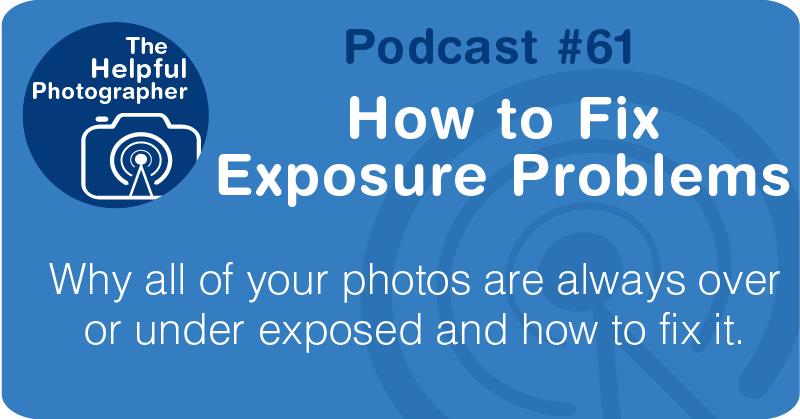Photo Tips Podcast: How to Fix Exposure Problems #61

iTunes
Google
Spotify
Tune In
Stitcher
RSS
Pandora
Transcript
Photo Tips Podcast: How to Fix Exposure Problems #61
Very often I see questions about bad exposure on various FB pages. People pondering why they seem to have to raise or lower their exposure in post process all the time and whether or not this is normal. In my experience there is generally only one thing that may render really bad exposures beyond user error, and that’s a broken meter. Yea I’m talking about something you can solidly blame on the camera and not the user. Unfortunately, after handling thousands of cameras over the past 10 years, I’ve only run into one… and it was only off by about 1 stop. Which in digital? Really isn’t that much of a problem. So a broken camera meter is usually not the culprit and I wish people would stop pointing their fingers at their amazing metering system!
The most common problem I’ve seen has been LCD issues. You need to know that every time you turn on your camera you are sending your LCD closer to its grave and so over time your camera’s LCD is likely to get darker and darker making you believe that your images are under exposed. The other big problem is your computer monitor, which suffers from the same issue as your camera’s LCD, which will also make you believe you have a metering problem. So obviously you don’t have a metering problem and your picture is probably fine. It’s just the display which is bad. To overcome this problem you can buy a calibration device which will allow you to calibrate your monitor so that you are looking at a consistent image over and over again. This will insure that you are not correcting your images for the changes your monitor is going through as it slips down that death spiral. But what about your camera’s LCD? The fact is that you cannot calibrate that, but there is a cheat. If you go into your settings and go to your LCD brightness setting you will be able to increase or decrease the brightness of the screen. You can also leave it on automatic. Unfortunately, in automatic the camera is changing the brightness of the image depending on how much ambient light is hitting the camera. So what you see in the shade will be different from what you see in direct light. And this is why I generally choose to leave my LCD brightness set to manual, and usually in the middle setting. If you find that your images look very dark or bright on your camera’s LCD what I would do is take a photo of something like the sidewalk; something that is about middle gray in tone and then just look at the LCD and see if image on the LCD looks almost like what you see with your eyes and then adjust the brightness levels accordingly. You should know that the ambient light around you affects the way your brain is perceiving the screen. So this isn’t an exact or perfect solution but it will get you close. And that’s all you need to do, is to get close.
With that in mind this is a good time to talk about your work space. Even if you have a calibrated computer monitor, you should be aware that the ambient light in the room will change how you see your monitor. So you might consider closing all the curtains in your workspace and make sure that you have dim full spectrum lights in the room.
Now before you go crazy making sure that your viewing conditions are absolutely perfect for your monitor, do remember that the vast majority of people out there DO NOT have calibrated monitors and are not viewing your images in perfect conditions. And so others will not see the photo as you see it. So far the problem is a bad or poorly set LCD. Do make sure that you have not set your LCD to be too bright or too dark.
So what about exposure problems caused by user error? The most common problem I see is that photographers have inadvertently changed their exposure compensation. So the camera is constantly over or under exposing their images. Unless you have a particular reason to move your metering away the middle, your setting should usually be at zero or in the center. Another user issue is improper metering. For instance if you are spot metering and you choose the wrong thing to meter on, or if you are exposure locking on the wrong thing; both will result in poorly exposed images. To get the proper exposure you must meter on something that is middle gray if you are using spot or center weighted metering. The last problem is a failure to understand how your meter works and how your scene is influencing that exposure. If you don’t understand this I covered it in the previous 2 podcasts.
The last thing I want to mention is your histogram. Unfortunately a histogram is not a reliable diagnostic as it won’t tell you how to fix the problem, only that there might be a problem. And it can only tell you that somehow your exposure is off, but not how or why it’s off.
I really hope that was helpful but I know there will be questions. Feel free to post those questions to our Facebook group.
